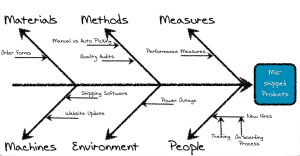Using Return on Investment and Cost Benefit Analysis in Process Improvement
Step Four: Prove It!
 As we continue along our process improvement journey we focus today on PROVE IT!
As we continue along our process improvement journey we focus today on PROVE IT!
But first, a little recap. So far we’ve taken you through the first three steps of The Whiteboard Way© (if you haven’t checked them out yet, here they are):
We’ve regaled you with:
- how to remove assumptions and pre-conceived ideas about the solution,
- to be unbiased and creative in the possible solution,
- then how to map a process to visually identify opportunities for improvement, and
- lastly how to imagine a potential solution.
And now the rubber hits the road – we need to do some math to determine if your solution will work! Our first task to to collect some data!
Collect the Data
We love to plan here at Whiteboard, and while often we want to jump the gun and just start collecting everything we can find, a great start is a data collection plan. It helps organize data collection activities and makes sure everyone involved with it understands the goals and objectives to provide the best data possible.
Consider asking the following (to yourself ,your project team, and your stakeholders):

- What data is needed?
- Who is responsible for getting it? Why is it needed ?
- How will it be collected?
- When will it be collected?
- Where will it be collected?
Cost Benefit Analysis
One of the biggest complaints we hear from teams and their management when we go to implement cost improvement activities are things like:
“We always try to tell management about these ideas, but they just ignore us!”
“Our teams have all these ideas, but they can never tell me why we should spend that much money on them!”
One of the reasons that great ideas often don’t fly is that they are missing rationale. Everyone can tout the benefits of process improvement initiatives, but its a skill to be able to articulate why the costs and efforts to implement are worth it. A cost/benefit analysis is a structured process for determining the trade-off between implementation costs and anticipated benefits of potential improvements. The analysis is done to ensure that a particular improvement is the most efficient one in a set of potential alternatives.
What is ROI?

Return on Investment (ROI) is the difference between the gain from investment and cost of investment divided by the cost of investment. ROI considers hard costs and savings (actual reductions in costs to the organization). The business case to prove your solution should also talk about soft costs and soft savings (other organizational benefits like employee engagement that don’t have dollar values associated with them).
ROI= (Gain from investment – Cost of investment)/cost of investment
So remember to consider the following when completing your cost/benefit analysis:
- All the costs associated with implementing the improvement
- Capital investment
- People costs (consultants, staff time)
- Training
- Lost production
- Determine the benefits of a fully-implemented improvement
- Calculate Return on Investment
- Keep it simple!
You might have come up with the best idea since sliced bread, but unless you talk about it, share it and explain it to others, it won’t happen! Stay tuned for our next blog on Talk About it! – how to communicate your process improvement idea!
Until then, please leave a comment – anything! Process questions, ideas for an upcoming blog, your thoughts on Toronto’s classy mayor…
Nicole



